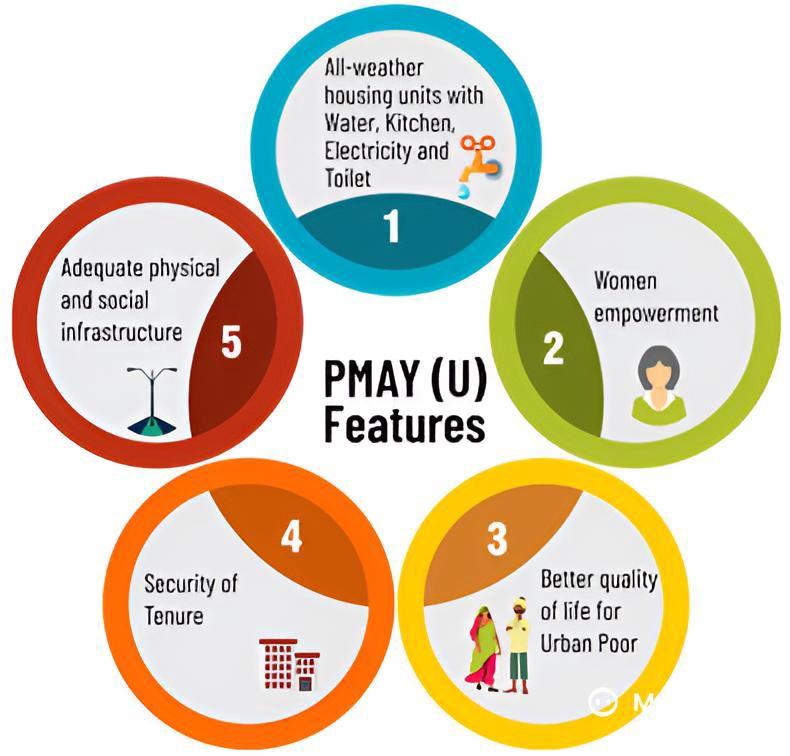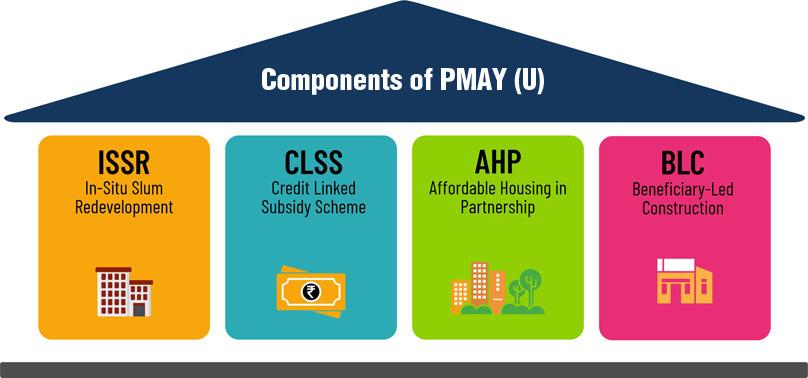Governance
Pradhan Mantri Awas Yojana – Urban (PMAY-U) 2.0
- 30 May 2025
- 8 min read
Key Points
|
What are the Key Features and Eligibility of PMAY-U 2.0?
- About: PMAY-U 2.0 (2024) is the revamped version of the original Pradhan Mantri Awas Yojana – Urban (PMAY-U) launched in 2015 to ensure affordable housing for urban households across India.
- The scheme aims to construct, purchase, or rent all-weather pucca houses for one crore poor and middle-class families.
- Implementation: It will be implemented over five years by States, Union Territories, and Primary Lending Institutions (PLIs).
- The Government has committed an investment of ₹10 lakh crore, with ₹2.30 lakh crore as subsidy assistance.
- Eligibility and Beneficiary Criteria: Eligible families must not own a pucca house anywhere in the country in any family member’s name.
- The scheme targets families under the Economically Weaker Section (EWS), Low Income Group (LIG), and Middle Income Group (MIG).
- EWS families have an annual income up to ₹3 lakh, while LIG income ranges between ₹3 to ₹6 lakh.
- MIG families have annual incomes ranging from ₹6 lakh to ₹9 lakh as per scheme guidelines.
- Adult earning members without property ownership are also considered separate households for eligibility purposes.
- Coverage Area: The scheme covers all statutory towns notified in the Census 2011 and towns notified subsequently by State Governments.
- Notified Planning Areas and regions under Urban Development or Industrial Authorities are included under PMAY-U 2.0.
What are the Components of PMAY-U 2.0?
- Beneficiary-Led Construction (BLC): BLC provides financial assistance to eligible EWS families for constructing houses on their own vacant land.
- States and Union Territories may provide land rights (pattas) to landless families for construction eligibility.
- Affordable Housing in Partnership (AHP): Under AHP, financial aid is given to beneficiaries for owning houses built in partnership with public or private bodies.
- Redeemable vouchers are provided to purchase houses in approved private projects meeting all required norms.
- Technology Innovation Grant (TIG) of ₹1,000 per square meter is provided for using innovative construction technologies.
- For innovative technologies, Central TIG of ₹3,000/square meter and State grant of ₹2,000/square meter are provided.
- Affordable Rental Housing (ARH): ARH aims to provide hygienic rental homes to migrant workers, students, destitute persons, and urban homeless.
- This vertical is implemented through two models involving the conversion of vacant houses and new constructions.
- Model 1 utilizes existing vacant government houses in cities through Public-Private Partnership arrangements.
- Model 2 allows public or private agencies to build, operate, and maintain new rental housing facilities.
- A slum redevelopment grant of ₹1 lakh per house is provided to eligible slum dwellers under the In-situ Slum Redevelopment under PMAY (U).
- This vertical is implemented through two models involving the conversion of vacant houses and new constructions.
- Interest Subsidy Scheme (ISS): ISS offers a 4% interest subsidy on home loans up to ₹25 lakh with house cost not exceeding ₹35 lakh.
- Subsidy is applicable on the first ₹8 lakh of the loan and is repayable over a 12-year tenure.
- A maximum subsidy of ₹1.80 lakh is transferred in five annual installments to beneficiary accounts.
How is PMAY-U 2.0 Funded and Implemented?
- Funding and Cost Sharing: PMAY-U 2.0 is implemented as a Centrally Sponsored Scheme, except the ISS component, which is a Central Sector Scheme.
- Cost sharing is between the Centre, State, and beneficiary, with fixed ratios depending on the region type.
- For Union Territories without legislatures, the entire cost is borne by the Central Government (100:0 ratio).
- North-Eastern States, Himachal Pradesh, Uttarakhand, Delhi, J&K, and Puducherry follow a 90:10 cost-sharing pattern.
- Other States follow a 60:40 sharing ratio, with the State contribution being mandatory under the scheme.
- The Government provides ₹2.50 lakh assistance per unit under AHP/BLC, and additional grants for technology use.
- Technology and Innovation Support: A dedicated Technology Innovation Sub-Mission (TISM) supports the use of green, disaster-resistant, and cost-effective technologies.
- States must adopt an Affordable Housing Policy to access PMAY-U 2.0 benefits and promote public-private participation.
- Monitoring and Governance: A real-time dashboard tracks physical and financial progress, house construction status, and central fund disbursement.
- Geo-tagging features integrated with the BHUVAN and Bharat Map platforms ensure ground verification of house construction.
- A Management Information System (MIS) connects all stakeholders for tracking demand surveys, fund flows, and beneficiary data.
- Direct Benefit Transfers (DBT) ensure assistance reaches beneficiaries directly in their bank accounts based on the construction stage.
- A unified PMAY-U 2.0 web portal launched in 2024 helps track applications, disbursements, and project progress online.
- Implementation involves local Urban Local Bodies (ULBs) preparing projects and State-Level Committees approving proposals.
- MoHUA conducts regular review meetings to resolve challenges like land acquisition, approvals, and beneficiary participation.
- Convergence with Other Schemes: States/UTs are encouraged to align PMAY-U 2.0 with schemes such as AMRUT 2.0, Smart Cities, Swachh Bharat, National Urban Livelihoods, PM Vishwakarma, National Health Mission, PM SVANidhi, Ayushman Bharat, Ujjwala, Ujala, and relevant state schemes.
Latest Update
- As of March 2025, the first Central Sanctioning and Monitoring Committee meeting under PMAY-U 2.0 approved over 3.52 lakh houses across 10 States and UTs.
- More than 2.67 lakh houses were sanctioned specifically for women, including single women and widows, and 90 houses were allotted to transgender beneficiaries.
- As of January 2025, PMAY-U has sanctioned a total of 118.64 lakh houses since 2015, with over 90.25 lakh houses completed and delivered to beneficiaries.
- The scheme currently covers 4,618 cities and urban local bodies, including all metropolitan areas across India.








